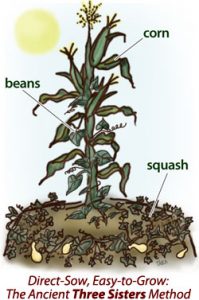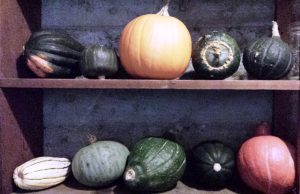Pumpkins have been grown on the North American continent for at least 7500 years. Only recently did they become associated with carving and pumpkin spice latte.
The pumpkin, Cucurbita pepo, belongs to the squash family along with the more familiar varieties of squash such as butternut, crookneck and acorn. Its common name comes from the Greek word for large melon, “pepon”.
Here are five things to know about pumpkins:
- “Peter Peter Pumpkin Eater” is one of those mysterious English nursery rhymes that doesn’t seem to make any sense. Keeping your wife in a pumpkin-shell? Iona and Peter Opie, the famed folklorists state that the rhyme comes from an older one called “Eeper Neeper”. It’s supposedly about a chimney sweeper who murdered his second wife and walled her up in a chimney. Nothing to do with pumpkins at all.
- The first pumpkin pie had no crust. The top of a ripe pumpkin was sliced off and the seeds and pulp were scooped out. The inside was then filled with cream, spices and honey, the top was replaced, and the pumpkin was baked in hot ashes until the outside was blackened and the inside was custardy-delicious.
- The first Jack-o-Lantern was a carved turnip. It originated from an Irish myth about a man named “Stingy Jack” . Imagine what a relief it must have been when the much easier-to-carve pumpkins finally made their way across the Atlantic Ocean.
- The right kind of pumpkin to use for pies, muffins and cakes is the pie or sugar pumpkin. They’re very symmetrical and smaller than Jack-o-Lantern-type pumpkins. To prepare the pumpkin, you can either pare off the skin and boil it for 30 minutes, or the way I prefer, bake in the oven. Either way, remove the seeds and pulp first.
- Three Sisters plantings of corn, runner beans, and squash or pumpkin were traditionally grown by the Haudenosaunee, a sovereign people composed of five (later six) Indigenous
 nations in Ontario , Quebec and Northern New York. The beans give nitrogen to the soil for corn and pumpkins; the corn stalks support the beans, and the pumpkin leaves provide ground cover that prevents weed growth and conserves moisture.
nations in Ontario , Quebec and Northern New York. The beans give nitrogen to the soil for corn and pumpkins; the corn stalks support the beans, and the pumpkin leaves provide ground cover that prevents weed growth and conserves moisture.
Reference:
I. Opie and P. Opie, The Oxford Dictionary of Nursery Rhymes (Oxford University Press, 2nd edn., 1997), p. 410.

